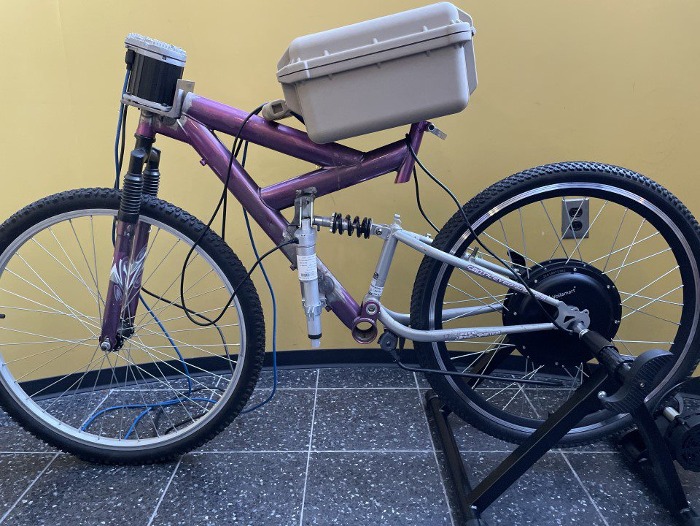
The senior design process tasks Drexel Engineering students with putting
everything they’ve learned over four-plus years in the classroom and on
co-op into one three-term long project. The collaboration with other
students, faculty and industry partners is a creative and scientific quest
to solve a problem, invent a gadget or innovate in an area of interest.
The sequence is meant to simulate real-world scenarios and teamwork as well
as to validate their earned skills as an engineer, which should come
naturally as they get set for graduation. In some ways, it’s like riding a
bike.
Or, in the case of one team, like teaching a bike to ride itself.
Under the mentorship of
Thomas Chmielewski, PhD ’95
, teaching professor of electrical and computer engineering and
Paul Kalata PhD
, associate professor emeritus of electrical and computer engineering, the
team is working to build a self-balancing bicycle that could be used as an
autonomous vehicle for delivery companies.
In addition to senior design, the project is part of the
SICK TiM$10K University Challenge
, a nationwide competition organized by SICK, a leader in sensor
technology. Teams are asked to use one of SICK’s LiDAR (light detecting and
ranging) sensors in a novel application that could be used for business
purposes. The Drexel team is one of 15 finalists who were provided with a
LiDAR sensor to continue their project after presenting their case to
judges.
The group consists of six students: electrical engineering majors Jacob
Longstreet and ShuoWen (Willie) Gu, computer engineering major Alix House,
and mechanical engineering majors Thomas Parker, Gaurav Pandey, and Avi
Majumdar.
To achieve balance, the team uses a number of sensors, including a Hall
effect sensor to measure the speed output of the motor attached to the
bike’s rear wheel, gyroscopes and accelerometers to monitor its lean angle,
and SICK’s LiDAR sensor to detect obstacles. The data is fed into a
processor, which creates a feedback loop that can tell the bike to go
faster or make steering adjustments to stay upright, or to slow down and
deploy its training wheels to navigate a busy area. Longstreet, the team
leader, explained that the team was constructed knowing that the project
would require multidisciplinary thinking.
“We knew we wanted to gather engineers from different backgrounds,” he
said. “Willie and I are working on making sure the sensors and the motors
work, Alix is working with the LiDAR sensor and coding the instructions
that are sent through the processor, and Thomas, Gaurav and Avi are working
on a miniature version of the bike using an Arduino processor that we can
use to test different ideas and get a sense of the equations we need to use
to keep angular momentum, velocity and other factors in mind.”
The team is still exploring multiple solutions for the project, including a
fly wheel installed at the bike’s center of gravity to generate torque to
counteract angular momentum and gravity, a servo motor to steer the bike’s
front wheel, and linear actuators to lower the safety wheels if needed.
They are also working on how to house the components in a protective case
that mounts to the bike, making sure that it doesn’t upset the center of
gravity, or at least that their sensors can account for it plus whatever
future delivery partners might want to carry on the bike.
They must consider all these factors while keeping the project safe and
cost effective to make the best case to the TIM$10K judges. The team makes
its final presentation for the competition in mid-April and will continue
to work on the bike through the end of the term to ensure that meets the
highest standards for a senior design project.
No matter what the outcome of the competition, the team is grateful for the
opportunity to work together to see a project through from inception to
completion.
“Senior design is an opportunity to use what you’ve learned over the past
four or five years, but also to learn from your peers,” Longstreet said.
“You get to enrich each other and understand how different backgrounds can
contribute to a project. It’s a fantastic opportunity to experience
real-world collaboration before graduating.”